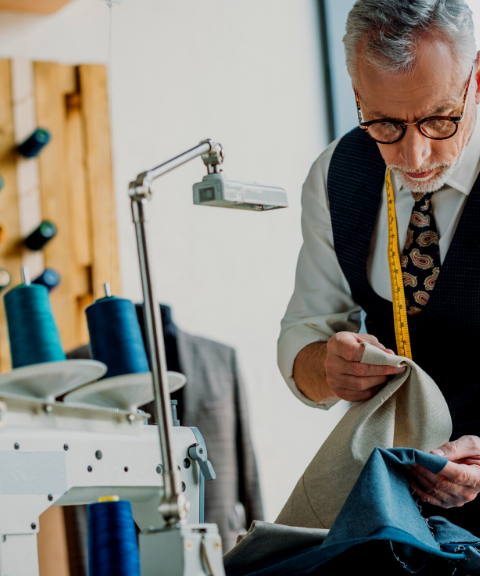Tailor Perth Specialists: Tailor-Made Solutions for Elegant Outfit
Tailor Perth Specialists: Tailor-Made Solutions for Elegant Outfit
Blog Article
Understanding the Tailoring Refine: From Fabric Choice to Final Suitable for the Ideal Wardrobe
The customizing procedure is an intricate interaction of art and science, starting with the important choice of fabric option and culminating in the exact modifications of final installations. Each fabric kind brings special top qualities that influence not just the visual appeal but also the garment's longevity and suitability for different occasions. Understanding the nuances of customizing strategies can raise one's closet to extraordinary degrees of elegance. As we discover these components even more, one must think about exactly how also the tiniest information can significantly impact the general result of one's individual style.
Value of Material Selection
Selecting the appropriate material is important in the customizing process, as it straight affects the convenience, toughness, and general visual of the final garment (tailor perth). The selection of material sets the structure for the garment's design, capability, and performance. Different textiles have distinct residential properties, such as stretch, weight, and breathability, which can substantially affect how the garment drapes and fits the body
Moreover, textile selection influences the garment's longevity and simplicity of care. High-grade materials can hold up against wear and tear, keeping their look and framework in time, while lower-quality products might result in pilling or fading. In addition, the ideal material adds to the garment's capability to shift throughout periods and occasions, consequently improving flexibility.
A customized item made from a proper textile not only showcases workmanship but likewise boosts the user's self-confidence. Subsequently, comprehending the subtleties of textile selection is paramount for any kind of customizing venture. It guarantees that the end product not just meets the aesthetic wishes of the customer yet additionally straightens with useful requirements, consequently attaining an unified balance between kind and function in the tailored closet.
Kinds Of Fabrics and Their Uses
Understanding the different kinds of textiles readily available is essential for making educated decisions throughout the tailoring procedure. Each material possesses one-of-a-kind qualities that determine its suitability for details garments and celebrations.
Its adaptability allows it to be tailored into whatever from shirts to outfits. Its natural flexibility aids garments preserve form over time.
Silk exudes luxury and is lightweight, making it excellent for eveningwear and delicate shirts; nonetheless, it calls for cautious handling due to its delicacy. Bed linen, with its distinctive surface, is a preferred selection for cozy environments, offering a crisp and ventilated feeling, yet it wrinkles conveniently, which may influence the garment's appearance.
Synthetic materials, such as polyester and nylon, deal resilience and resistance to wrinkles, making them appropriate for everyday wear and active clothes. Comprehending these material types and their homes enables better decision-making, making sure that each customized item not only fits well however likewise straightens with the intended purpose and event.
The Tailoring Methods Explained
The art of customizing counts on a range of methods that change material right into well-fitted garments. Central to this procedure is pattern drafting, where a dressmaker develops templates based upon the client's measurements and desired style. This initial action ensures that the garment will fit the user appropriately before any type of reducing takes place.
When patterns are developed, reducing methods enter play. Accuracy is paramount as inaccuracies can bring about misfitting garments. Tailors commonly utilize different reducing techniques, such as single-layer cutting for elaborate layouts and multiple-layer cutting for effectiveness on conventional patterns.
Basting is one more vital method, enabling dressmakers to momentarily stitch fabric assemble for a preliminary installation. This method offers the chance to evaluate the drape and overall silhouette before last stitching.
Seaming strategies, including french joints and flat-felled joints, boost the garment's durability and visual appeal. Tailors also employ techniques such as interfacing and padding to give structure and form to details locations, like collars and shoulders.
Finally, completing techniques, consisting of hemming and edge finishing, make sure the garment's long life while providing a refined appearance. With each other, these methods create the backbone of reliable tailoring, resulting in charming, custom-fit clothing.
Suitable Changes and Factors To Consider

Secret considerations consist of the shoulder fit, which must neither sag neither restrict movement, and the sleeve size, which need to enable comfortable arm movement while preserving a refined look. In addition, modifications at the waistline can refine the silhouette, with choices to allow out or absorb textile as needed.
The rise of trousers is one more critical aspect; it must rest conveniently over the hips without creating discomfort, permitting convenience of movement. Hemming lengths for both pants and skirts should show the wearer's favored design while appreciating percentages.

Maintaining Your Tailored Attire
Always comply with the care label guidelines, which may recommend completely dry cleansing for delicate materials or device cleaning for more durable materials. Prevent regular laundering, as this can put on down the fabric and modify the garment's shape.
Storage space is equally essential; use padded wall mounts for coats and coats to preserve shoulder structure, and shop pants folded up neatly or hung to stop creasing. Secure garments from straight sunlight, which can discolor colors and damage fibers.
Furthermore, regular official statement evaluations for minor repairs can prevent larger issues. Look for loose buttons, tearing joints, or indications of moth damages, dealing with these problems immediately to maintain the garment's integrity.
Finally, take into consideration seasonal turning. Putting on customized items in small amounts permits textiles to recoup, prolonging their life-span. By applying these upkeep approaches, you can guarantee that your customized garments stay as immaculate as the day you initially wore them, improving your suitable closet for several years to find.
Conclusion
The customizing procedure, encompassing textile option, experienced strategies, and specific suitable adjustments, plays a vital function in creating garments that improve both comfort and style. Recognizing the value of upkeep prolongs the life of tailored garments, solidifying their value in a well-curated closet.
Picking the appropriate textile is crucial in the tailoring process, he has a good point as it directly influences the comfort, resilience, and general visual of the last garment. The selection of material establishes the foundation for the garment's style, performance, and performance. Different fabrics have distinct residential properties, such as weight, stretch, and breathability, which can considerably affect exactly how the garment drapes and fits the body.
The art of customizing depends on a range of techniques that change fabric right into well-fitted garments.The customizing process, incorporating textile option, knowledgeable methods, and accurate fitting adjustments, plays a critical role in producing garments that enhance both comfort and design.
Report this page